
【Exclusive Interview】Part 2 : James Zorab – Lowland Bond – Edinburgh Whisky
- 造り手
- 樽・蒸留器・倉庫
 アイキャッチ231009-11.png)
Despite its old and traditional-looking building, covered with heavy stone walls, The Borders Distillery is one of the most famous front runners in environmentally sustainable whisky production. With a combination of Border’s culture and modern ideologies, The Borders distillery is still in the process of forming its legacy as a young distillery.
An interview with John Fordyce, one of the distillery’s founder, and Kirsten Blackburn, head of marketing, revealed the philosophy behind bringing back whisky production to Hawick, Scotland.

| Company’s Name | The Borders Distillery |
| Year of Establishment | 2018 |
| Founders | John Fordyce, Tim Carton, John Roberts, and George Tait |
| Location | The Borders Distillery, Hawick, Scottish Borders, TD9 7AQ, United Kingdom |
| Official Website | The Borders Distillery |
Dear WHISKY:
What is your background
John:
Originally, I am from Scotland, and I used to work in the sewing thread industry. Then, I switched to the whisky industry and worked for Glenfiddich until 2004. From there, I moved to Portugal and did wine and olive oil businesses. During that period, I got some blending experiences through owning a vineyard and managing my wine brand. I came back to Scotland in 2013 after 30 years of traveling. I established the Three Stills Company with three friends, ultimately opening the first whisky distillery since 1837 in the Scottish Borders.
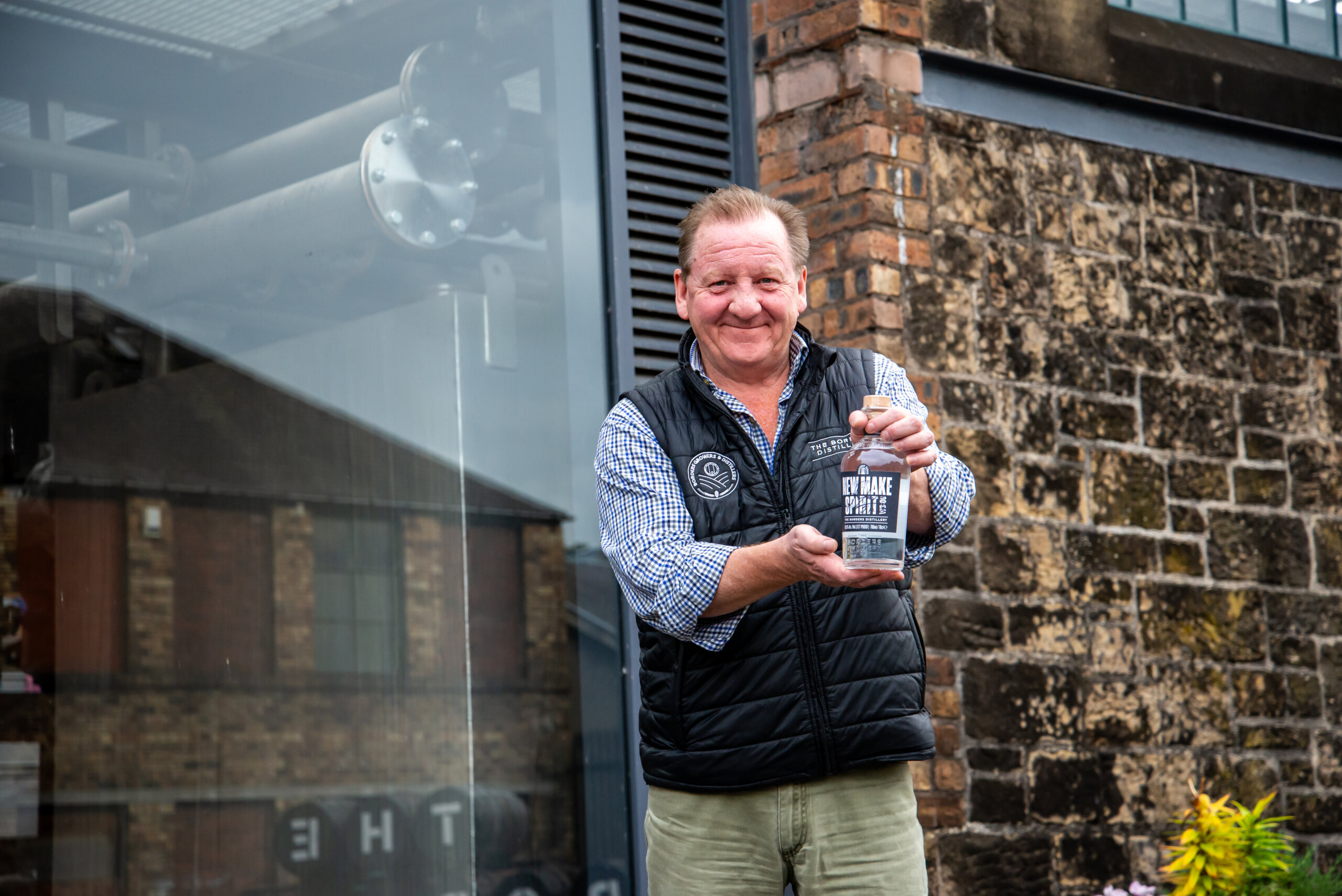
John holding their New Make spirit in front of the distillery
Dear WHISKY:
Why did you choose Hawick to build a distillery?
John:
We decided to build a distillery where there were no other distilleries around. The only place left in Scotland without a distillery was the Borders. Once we determined the region, we went around all the towns to find a suitable building with enough water source, nearby farms, and not too far away from the maltster. And Hawick ended up being the best place.
Dear WHISKY:
Why were there no distillery ?
John:
I have no idea. It just didn’t happen. There was a distillery here in the far past, but it closed in 1837. I don’t know why there were no other distilleries here after that, but we are lucky there wasn’t.

John with the 50 to 1 model of the distillery
Dear WHISKY:
What did the construction process look like?
John:
This whole thing was the rejuvenation project, so we did not build this facility from scratch. Although it is hard to find a suitable place and design it properly, it is better to restore an old building than construct a brand-new building. Considering how much embodied carbon emissions building a new distillery would cause, it was more reasonable for me to find an old unused building, refurbish and repurpose it as a distillery.
Dear WHISKY:
Was this idea based on the Net Zero carbon movement?
John:
We were slightly ahead of that. We care about embodied carbon and believe that there already is too much carbon in our system, to the point that we don’t need any more added. Since there are enough already, we can reuse and recycle all the materials.
Dear WHISKY:
What was the hardest thing about establishing the distillery?
John:
Restoring the building probably was the most complex challenge. It was in an awful state since it was abandoned for a long time. All the windows were broken, so they had to be replaced, and so on. It took so much care to put everything back into its former glory.
Dear WHISKY:
Why was it abandoned?
John:
The story is that the company that was previous to us outgrew the building, and it was too big for this site. Eventually, they moved to a new place, but this building was still quite big for other companies. This site needed another well-established company to take over, which this area had not had for a while back then.
Dear WHISKY:
Could you share the initial idea and the backstory of the building and its rejuvenation project?
Kirsten:
It used to be owned by an electric-engineered firm. The idea was that the silhouette of the building would always stay the same and that local people walking past the building wouldn’t notice that it was different or anything had changed. This is so that, the building would still felt very part of the town and familiar to it’s people, but the idea was that we transformed the interior of the building. We wanted the body of the building to be functional and productive. It is all about bringing an industry back to the town.
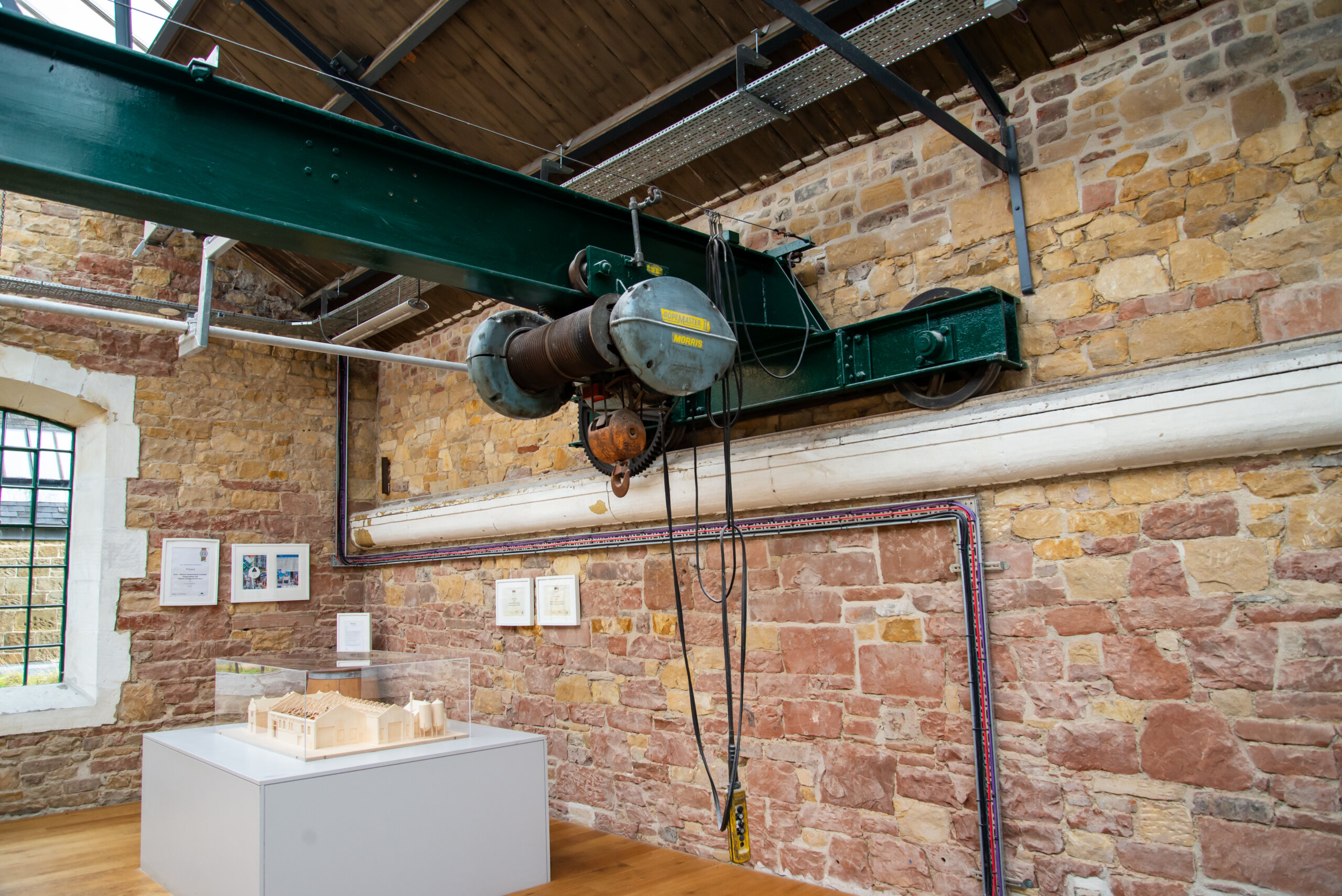
Some machinery from the old factory is still kept.
Dear WHISKY:
So the building hasn’t changed much?
Kirsten:
We still have the old-school photos of what the building used to look like. We installed a floor in the mash house and all of the pipe work for the distillery is under here. So we’ve built a floor and decided this room into two floors. Borders Distillery is interesting because we’ve rejuvenated and brought back to town an industry that didn’t exist here by utilizing the old buildings in town.
Dear WHISKY:
How did you get local people involved into this new industry?
Kirsten:
It relates to another interesting fact about this distillery: the people we employ here. They are all local Borders people, and many are very young. Therefore, bringing new people into the industry felt natural as a brand-new distillery. So we’ve needed some whisky veterans who have helped us along the way and supported building the knowledge. People who have worked in whisky for a really long time have helped us and shared their wisdom.
Dear WHISKY:
What are they responsible for?
Kirsten:
Jim, for example, is one of our distillers here. He worked for years and years for Diageo and all the other big brands. We managed to persuade him to come and work for us before he retires! What he does is guide a lot of the younger members of staff. That has allowed new members of staff to control the distilling process comfortably despite being a very young team as a distillery.
Dear WHISKY:
Was bringing those veterans and new industry into town was your main focus?
Kirsten:
While I think it’s vital that we’ve brought whisky-making back to Borders, what is more important is that we’ve also involved the town’s local people. It is so exciting that we’ve given young people in the town career opportunities they wouldn’t have had before establishing the distillery.
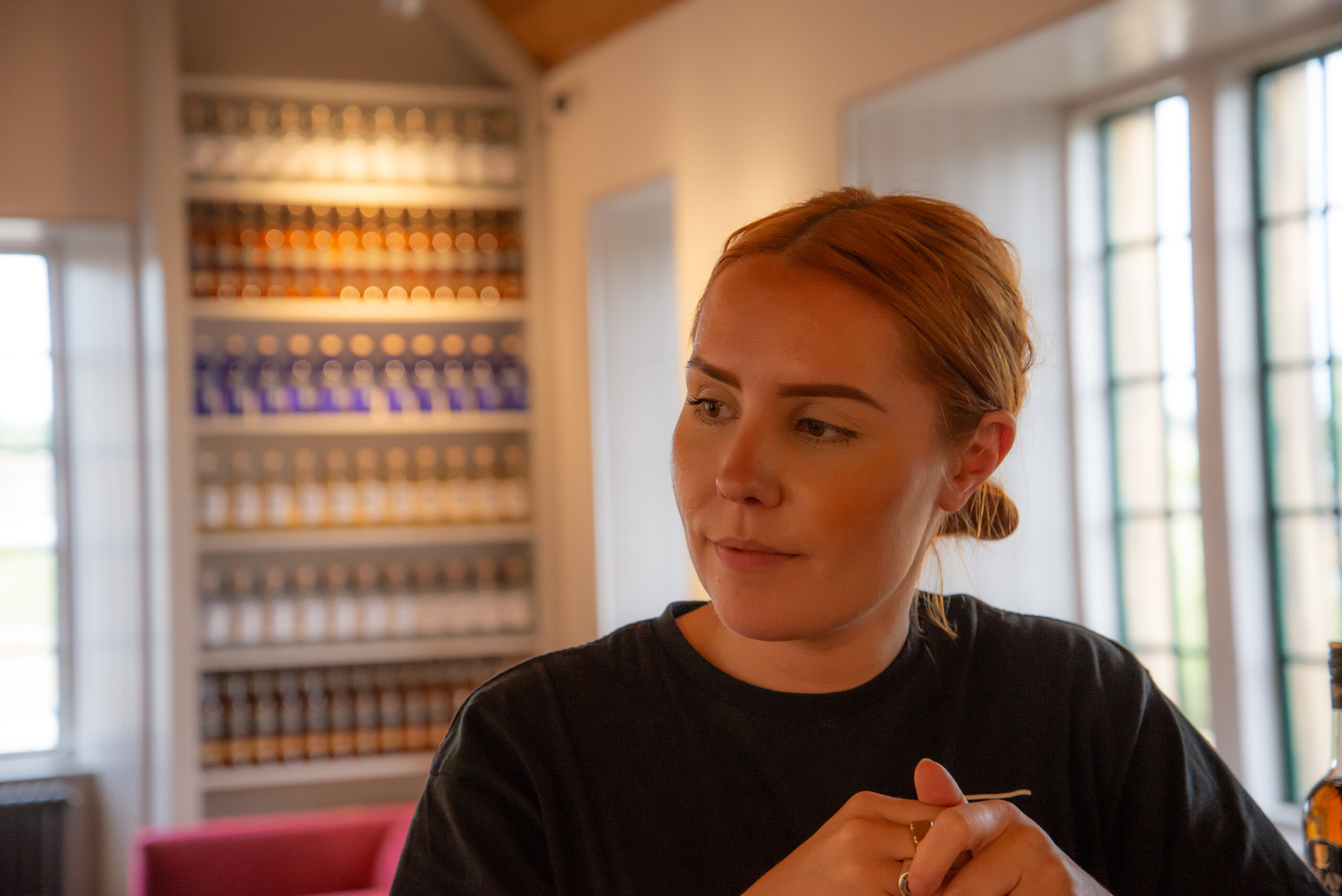
Kirsten, originally from Hawick herself, sharing the local people’s impressions
Dear WHISKY:
As a person originally from this area, what was your initial impression for the new distillery being built in town?
Kirsten:
It was fascinating; seeing a new industry enter the town is incredible. As mentioned, Hawick is a very manufactured and focused town regarding tweeds and cashmere. It comes second nature to us as a town to produce and manufacture luxury goods. Therefore, it certainly makes sense to bring whisky into that conversation.
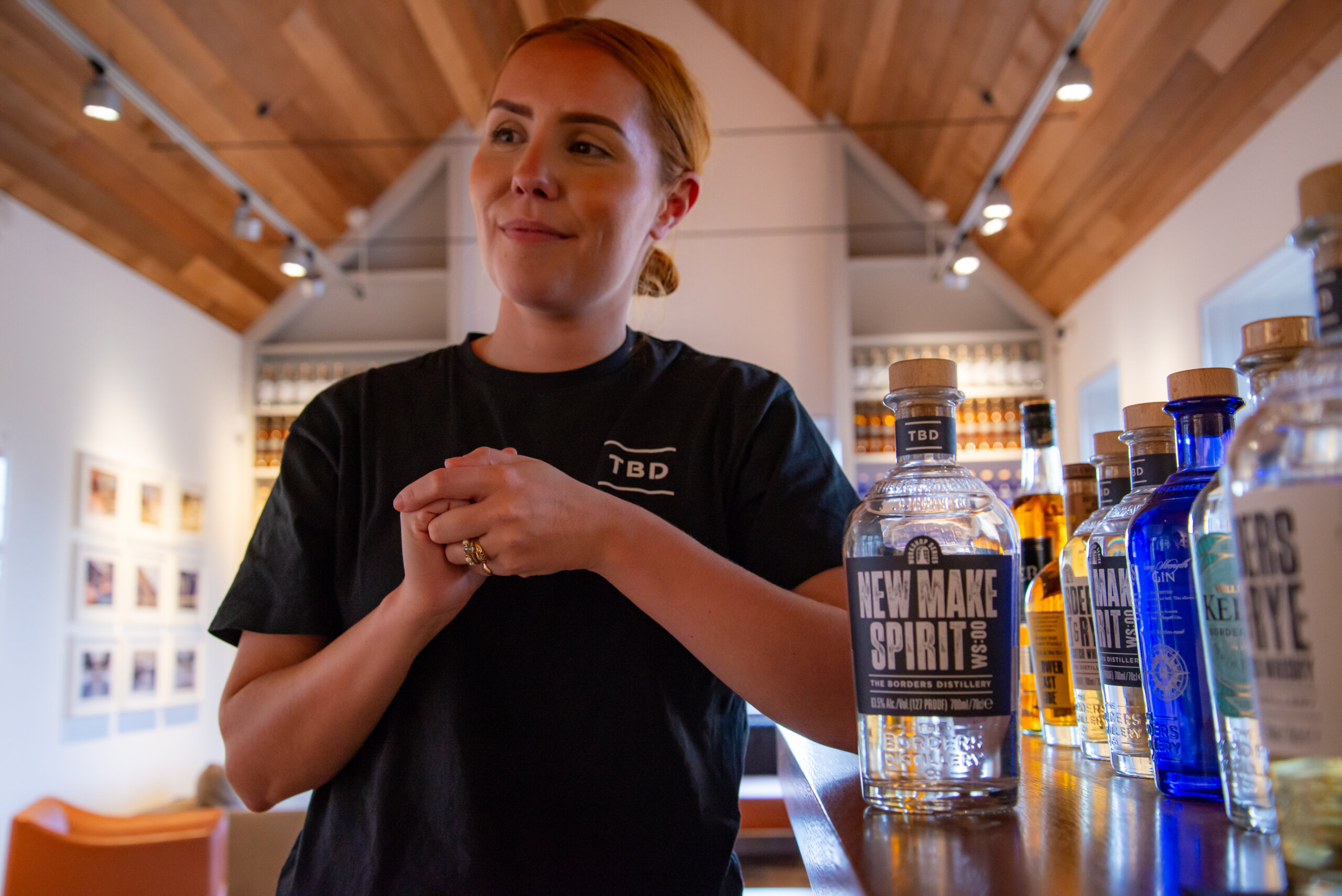
Kirsten and their New make spirits.
Dear WHISKY:
What was the public’s reaction to this project?
John:
Great, we won the Civic Trust Award, an international architecture award. We are so proud of this since it genuinely announces that we care about this issue and made a public commitment. Additionally, we received an award for Conservation issued by the Royal Society of Architects.
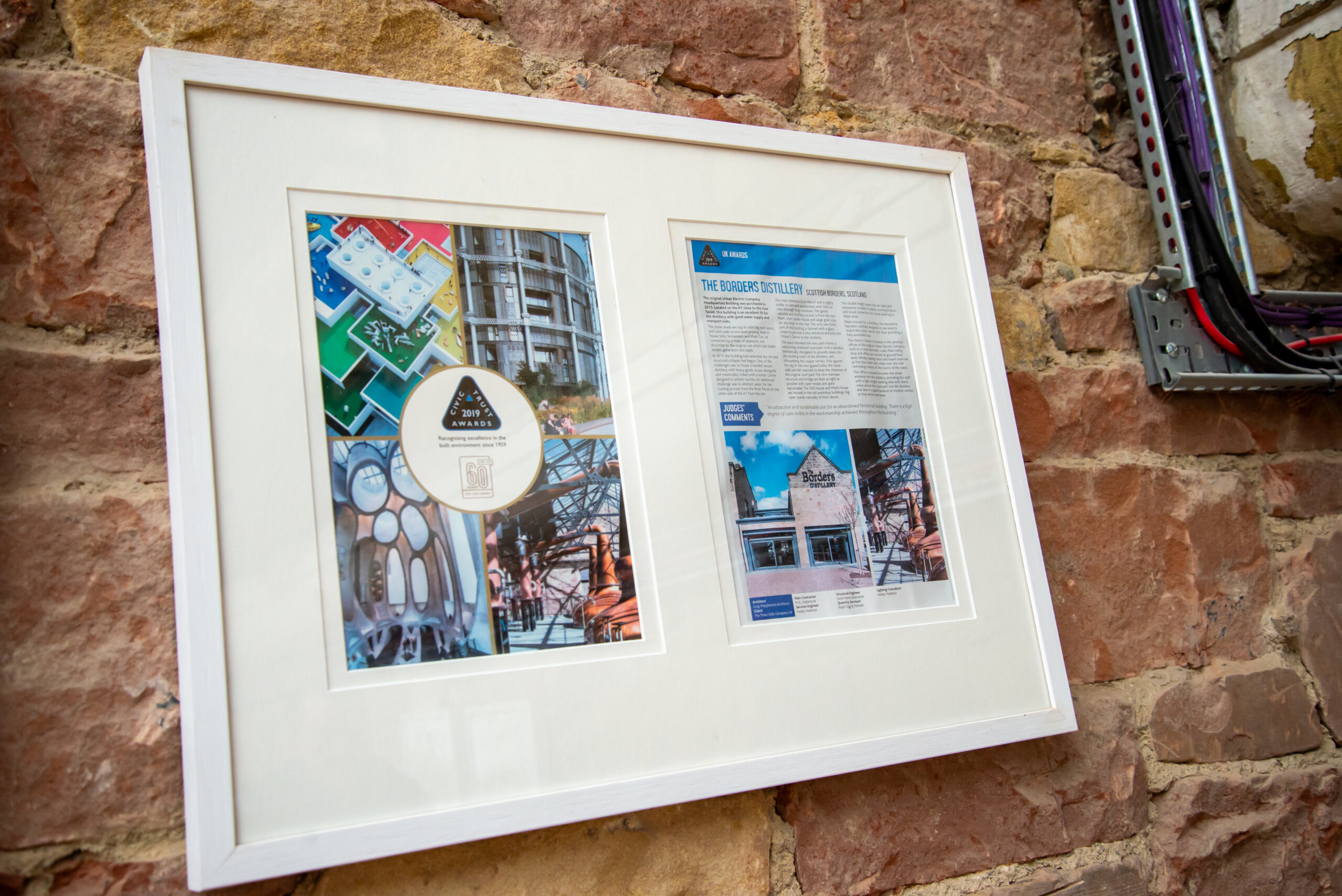
Civic Trust Award 2019
Dear WHISKY:
I saw a document from the Scotch Whisky Association (SWA) in the lobby. Could you explain the distillery’s relationship with SWA?
John:
Since we made all those commitments and contributions towards sustainability within Scotland, we now work with them to discuss the environmental constraints with them. We collaborate with SWA to promote environmental sustainability and help them develop policies.
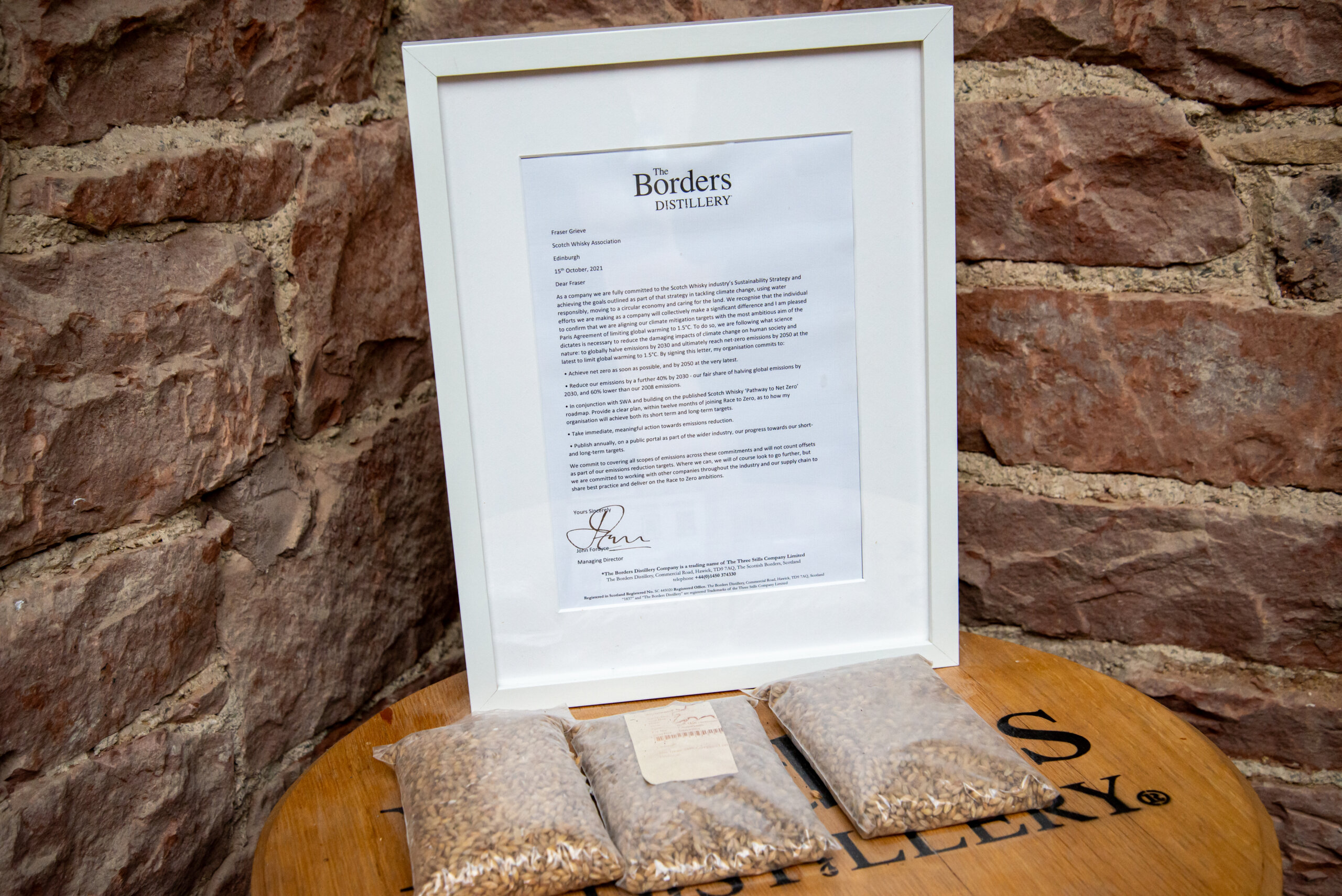
Document from the Scotch Whisky Association
Dear WHISKY:
What made you care so much about the environment?
John:
Since whisky production is such a time-consuming process, our consumers and drinkers are often 5-10 years in front of us. So we sat down and tried to determine what young people would think in 10 years. And we decided that the environment is crucial.
Dear WHISKY:
Does not caring a lot about these constraints prohibit productivity?
John:
Many people think it that way, but in reality, there is no contradiction. There’s no fight between the environmental agenda and manufacturing because it’s all about productivity. At the end of the day, it’s all about getting more from less. So we want the same output for less energy and less waste. That’s what the environmental agenda actually is. Therefore, it’s effortless for us to go in that direction, caring more about sustainability and productivity simultaneously.
Dear WHISKY:
What makes implementing such progressive eco-friendly ideas possible for The Borders Distillery?
John:
As a brand-new distillery, I can pick up all the necessary materials to achieve that goal because there are no legacies or traditions to be conservative about. I can choose new technologies and ways of thinking as I wish without hurting the distillery’s legacy since we are in the middle of creating one.

Conservation and Climate Change Award 2019
Dear WHISKY:
What kind of people works at the distillery?
John:
The majority of our distillers are women, and they are all from the local area. Their average age is around 25, relatively young as a distillery. They didn’t necessarily have expertise in whisky, but we have our system for training people from scratch. This efficient education works very well to the point that they all can get their professional qualification called the General Certificate of Distilling. This is the global certificate that the International Institute for Brewing and Distilling gives out.
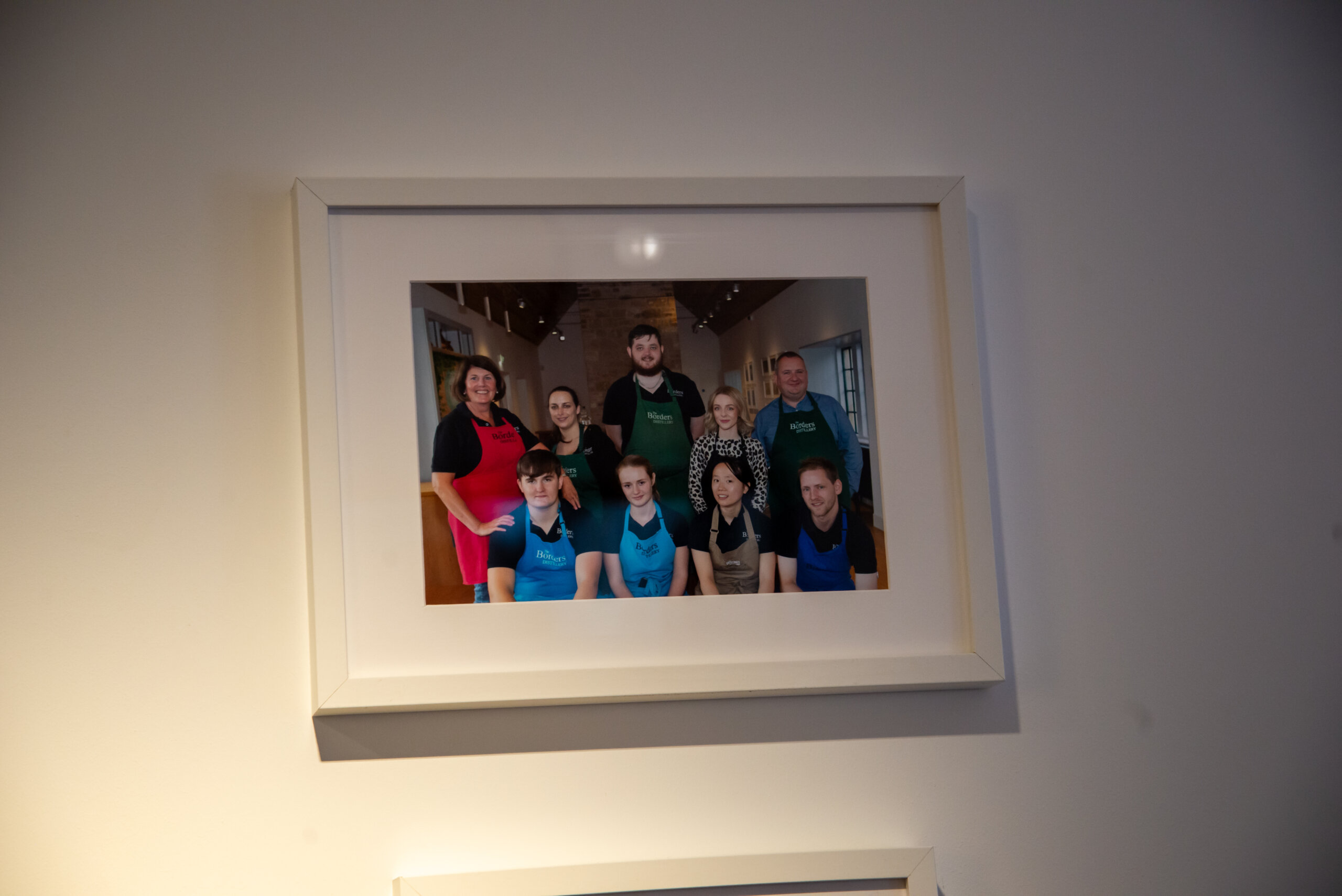
Their distillers. Out of 11 distillers, 7 of them are female
Dear WHISKY:
Whisky distillery is a male-dominant industry. What about The Borders Distillery attract female so much?
John:
It is a natural thing to happen. Hawick is a big manufacturing town; traditionally, most factory workers are women. Therefore, although it is unusual for the whisky industry, it is customary in Hawick.
Dear WHISKY:
What does your training look like?
John:
It is unlike any seminars, classes, or anything, just through mentoring. We have a veteran distiller called Jim, who used to be working at Diageo for a long time, and he teaches them at the beginning. From there, we put experienced and inexperienced distillers in a team and worked together. Gradually, they learn and master everything, which takes around two years.

Certificate in Distilling, issued by the Institute of Brewing & Distilling
Dear WHISKY:
How do you train your tour guides?
John:
We don’t have specialized tour guides; it’s just our distillers who show the site around. Due to that, there is no specific training for touring because if you’re a distiller, you’re simply explaining your job; it’s easy. This also means every tour offers a different experience because each distiller has a different view and takes on their job, and we don’t train them to say certain things.
Dear WHISKY:
Where do you source the barley from?
Kirsten:
We are fortunate that we have developed a supply chain that’s so internal, meaning all the barleys are sourced within Borders, mostly 35 miles within the distillery. And we have strong links with our supply chain that allow us to stay in touch and build relationships.
Dear WHISKY:
How did you create that strong link with the local farmers?
Kirsten:
We have never used a barley outside of this region. This means that the ethos of the border spirits is formed through this distillery. It’s very reflective of our region because it’s so specific to us, and it’s all made here. It’s a great thing, but it also means that there’s a huge responsibility. We have to decide what we want the barley to say and what we want it to taste like. And after all, everyone’s looking at us to define what the Scottish Border’s spirit tastes like.

Spirits they make, displayed on the wall
Dear WHISKY:
What did the establishment process look like?
John:
The first few years were about establishing the site, finding the staff, understanding what quality of spirit we wanted to make, and what stories we wanted to tell. Then, more recently, it’s about identifying who we are as a brand and where we want to stand in the whisky market. Since we are new, trying to be traditional with how we represent the brand doesn’t make much sense because we don’t have a heritage to rely on. Other distilleries in Scotland have been there for 50 or sometimes 100 years and have very distinct and stubborn traditions and legacy.
Dear WHISKY:
Do you consider not having those legacies as an advantage?
Kirsten:
Because we don’t have that, we can now ask ourselves: what do we want to say through the whisky, or what are we bringing to the table that’s new, exciting, and different? So I think that’s very much the journey that we’re on now.
Dear WHISKY:
How has the journey been so far?
Kirsten:
Last year, we released “the Malt and Rye”, our first whisky from the distillery and the first blend from the Borders in 185 years. This is our first mark in the whisky world. This is what we’re about; this is what we do. Then, the second Workshop Series, “The Long and Short of It,” will be out on the 26th of October. It’ll be a limited release with only 8400 bottles available. This specific series experimented the potential of the fermentation stage.
Dear WHISKY:
Will you do something special as you release that series?
Kirsten:
We will do something locally. Whenever we have a local event in the Borders, we invite locals to come over and let them taste the samples
Dear WHISKY:
Are events and festivals popular among the Borders region?
Kirsten:
Summer is a season for traditional festivals in the Borders. Border’s unique festivals, such as Weavers festivals or common riding festivals happen during the summer. Winter, on the other hand, is much quieter, except for Christmas.

The Borders Distillery is situated close to the local town
Dear WHISKY:
Did you hold many events at the distillery over the summer?
Kirsten:
Yes, we have welcomed people on a much more global scale this year. Even though last year was normal in terms of post-pandemic, this year has been even busier with international tourists. We’ve had even more different accents come through, and it’s been great to hear so many people from around the world visit the distillery so they can come for a tour and visit our shop.
Dear WHISKY:
Where do they come from?
Kirsten:
Lots and lots of Americans, which is to be expected, and quite a lot of Dutch. Some people from India and Japan as well. Mostly European or American, I would say.
Dear WHISKY:
Is Hawick popular among a tourist?
Kirsten:
I would assume when they’re coming to Hawick; they’re coming for a much bigger picture. Hawick is famous for its textile manufacturing. We make Kashmir and tweet, which people come here for, a cashmere jumper. Traditionally, it was common for tourists to buy a tweet jacket, but they also buy a bottle of whisky now.
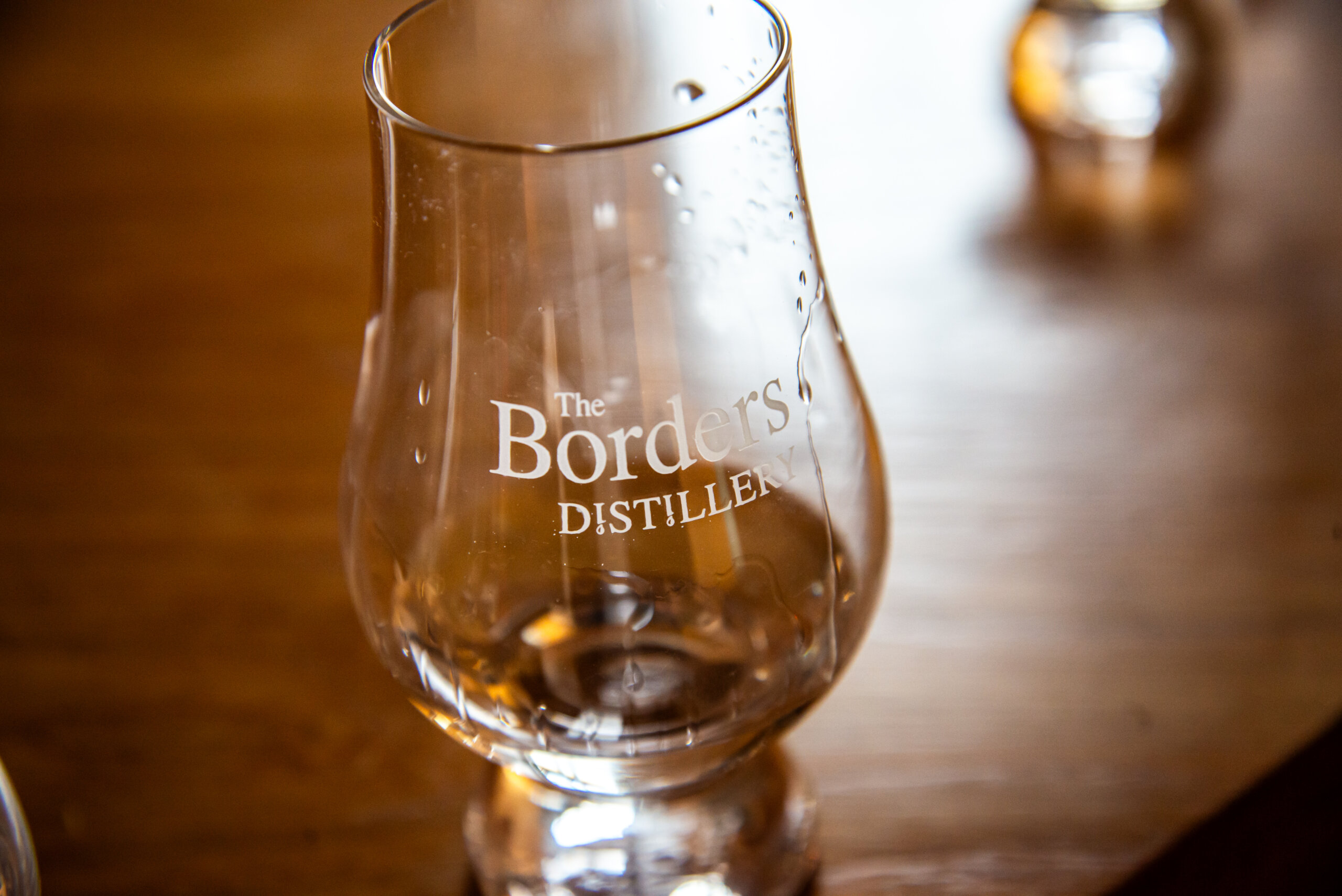
New Make spirit available during the tour
Dear WHISKY:
What else do you think buys into the tourism as well?
John:
People visit the borders because it’s quite a different landscape from elsewhere in Scotland. Although it is green and hilly like lots of other places in Scotland, but I think it’s much softer here. The hills are much more peaceful, and we have many more valleys. On top of that, each and all Border towns have their own unique thing to offer. People come to Hawick to get glimpses of what the borders offer.
Dear WHISKY:
How is the accessibility and transportation here?
John:
There’s a train from Edinburg to Galashiels or Tweedbank. People come from the Netherlands to visit Edinburgh, maybe spend a day, and prefer to hang out in the countryside on the weekends. If you’re coming from the Netherlands or Europe, many people get the ferry from Amsterdam to Newcastle. Since Hawick is right in the middle between Newcastle and Edinburgh, we fortunately get a lot of people coming off the ferry from Amsterdam.
Dear WHISKY:
Could you explain about the Private Whisky Cask?
John:
It is a scheme where you can buy your cask. You can bottle them into 240 bottles with private labels on them.
Dear WHISKY:
How much does the cask cost?
John:
2,400 pounds, and you pay nothing else for the next ten years. You can choose your label when bottling, and it gets shipped to the UK port. If you wish to keep it longer than ten years, you simply pay 20 pounds yearly for an additional storage fee.
Dear WHISKY:
How many types of casks are there?
John:
4 in total: bourbon, bourbon refill, rum, and rye. They all cost the same. New spirits go in, and you just wait for ten years.
Dear WHISKY:
How can the customer check the state of the cask?
John:
We have this app to track the maturation. You can run your finger across the screen, and a spidergram will show the taste panel. Owners can check and be updated about how your whisky’s flavor is evolving over time.
Dear WHISKY:
That’s a fabulous technology.
John:
Yes, it is; things are pretty modern here despite its old-fashioned look outside. We even have the electronic template for the bottling stage. That’s where you choose your bottle and label, and if you wish, you can ask the designer to design something totally original.
Dear WHISKY:
What kind of people buys those casks?
John:
People worldwide purchased it from Hong Kong, America, Germany, Belgium, and the UK. I have seen many parents and grandparents giving them as a present for their children and babies.
Dear WHISKY:
Do they purchase the cask on their own?
John:
Not mainly; the most prominent customers are ten people getting together to buy a cask. It’s common among Americans to pay 10% each and share the holdings of 10% each. They travel together to look at the cask as part of their Scotland trip.
Dear WHISKY:
How many owners are there as of now?
John:
We have around 700 owners from about ten countries four years since the launch. The owners’ community is growing, and that is so crucial.
Dear WHISKY:
Why is the owners’community so important?
John:
It’s all about collaborating and helping each other. Owners get to contact each other using the app. So when you bottle your cask, you can invite another owner to combine and bottle it together. That way, there would be enough bottles to sell in the market.
Dear WHISKY:
Are there any memorable events since you established this distillery?
John:
There are many. Making the first drop of whisky in March of 2018 was very exciting. Winning the sustainability awards and our distiller’s achievement were also significant. Their passion and effort to learn how to become professional distillers and qualified distillers was fantastic to watch.
Dear WHISKY:
What would be the next goal for the distillery?
John:
For now, we have to focus on the most essential thing, launching the malt, which will probably take a long time to organize. We will eventually decide on 5 to 10 clients worldwide and launch our malt whisky with them.

John in front of the distillery
The Borders Distillery’s remarkable take on sustainability and productivity hints at the suggestion of clean whisky production as an industry. Utilizing modern technologies while paying respect to the town’s culture and atmosphere reveals the distillery’s steadfast devotion to manufacturing whisky in such a history-rich area. The distillery’s existence and passion bring Hawick a sustainable infrastructure for an advanced economy, leading to a better employment, environment, and increased tourism.